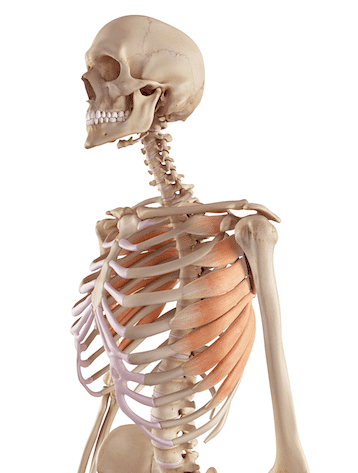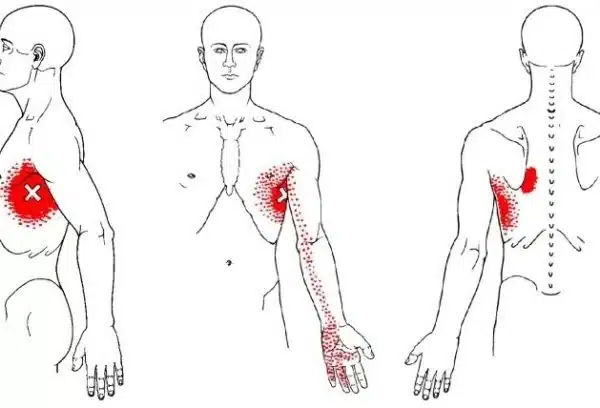Serratus Anterior Trigger Points and Effective Relief Strategies
If you’ve been dealing with pain or discomfort along your ribs or around your shoulder blades, you may have trigger points in your serratus anterior muscle. These sneaky trigger points can cause all sorts of annoying symptoms.
In this article, we’ll look at what the serratus anterior muscle does, what causes trigger points to form, and most importantly – how to get relief.

Anatomy and Function of the Serratus Anterior
The serratus anterior is a large muscle that originates along the side of your ribcage. It’s the area that occupies your upper five ribs, runs under your armpit, and wraps around to attach to the inner border of your shoulder blade.
This large muscle forms the medial wall of your axilla (arm pit) and covers the lateral ribs up to around your mid-back. It has a fascia covering, and digitation attaches to the external oblique muscle.
The main functions of the serratus anterior are;
- Protracting the scapula (pulling shoulder blade forward)
- Upward rotation of the scapula
- Support your shoulder girdle
- Supports breathing by elevating your ribs
It’s a key muscle for facilitating pushing movements like push-ups, pull-ups, throwing, and punching. No wonder it’s nicknamed the “boxer’s muscle.”

Serratus Anterior Muscle Pain
Let’s talk about that annoying pain you might feel along your ribs or around your scapula, which you probably call chest pain. If your ribs feel like a really deep ache or stabbing pain under your arm around your ribs, it could be your serratus anterior muscle hurting. (but always check with your physical first if you’re feeling any kind of chest pain!)
When this muscle group gets injured or irritated, it can cause pain in your chest wall that you’ll really notice, especially when you move your arm or take a deep breath.
You might feel the pain strongly when you press on the sore spots against your chest wall, along your ribs under your arm. The pain might even wrap around your side to your back by your shoulder blade. Making an upward rotation of your arm can also worsen the pain.
But please don’t confuse this localized pain for C8 nerve problems. The latter often presents sensations down the inner arm towards the palm, especially affecting the fifth digit (little finger) and fourth digit.
If you start feeling a deep, aching pain along your ribs that just won’t go away, it could be a trigger point activation. Given the complex nature of this muscle, accurate evaluation is key to pinpointing any active central myofascial pain.
Signs and Symptoms of Serratus Anterior Trigger Points

Image reference: David G. Simons, Janet G. Travell, Lois S. Simons. Myofascial Pain and Dysfunction: The Trigger Point Manual
When a trigger point forms in the serratus anterior, it can cause various symptoms, including;
- Persistent pain along your ribs that may radiate around to your rib cage or shoulder blade
- Tenderness at specific spots on your ribs or around your scapula
- Difficulty during deep breathing due to rib pain
- Shoulder pain when reaching overhead or behind you
- Pain or numbness down your arm
- Scapular winging (shoulder blade protruding)
The pain is usually felt along the muscle fibers, though it can radiate to nearby areas. It may come and go.
Common Causes of Serratus Anterior Trigger Points
Activities that overuse or strain the serratus anterior can lead to trigger points;
- Repetitive overhead motions (think painting, serving in tennis, throwing)
- Push-ups or pull-ups with poor form
- Heavy lifting with arms extended
- Sudden movements like catching a falling object
- Sports like rowing, boxing, or baseball use the serratus anterior extensively
- Sustaining ribs in an extended position during yoga poses
- Whiplash injuries
- Violent coughing fits
- Poor posture over time
Sometimes, even minor trauma, like a bump or blow to the ribs or muscle, can cause a trigger point to form. Once they develop, trigger points restrict blood flow and cause pain – often leading to immobility and more trigger points. It becomes a vicious cycle.
Effective Serratus Anterior Trigger Point Relief Strategies
If you suspect you have serratus anterior pain, don’t worry – there are several ways of treating trigger points. Here are some effective treatment strategies.
Self-Massage Techniques
You can DIY massage therapy to relieve the pain patterns. Using a massage ball, foam roller, or your fingers, apply pressure to tender spots for 30-90 seconds to release tension. Try massaging along your ribs and around the inner border of your scapula. Go slowly and breathe deeply.
Stretches and Exercises
Gently stretching and strengthening the serratus anterior can help alleviate trigger points. Try scapula squeezes, shoulder rolls, and movements like push-ups plus and lawnmower pulls. Avoid overexerting the muscle.
Professional Treatments
Physical therapy is another crucial relief strategy for your pain. Physical therapists use techniques like dry needling and manual trigger point physical therapy. Massage therapists may employ myofascial release, friction massage, or other specialized techniques to address trigger points.
Lifestyle Modifications
Improving posture, limiting overuse of your arms, and avoiding repetitive strain or sudden trauma can prevent trigger points from recurring. Don’t slouch. Manage stress levels and stay active, but listen to your body. If you really have a bad cough that can alleviate your pain, ensure to drink a lot of water.
Relaxation Techniques
Practices like breathing exercises, meditation, and yoga can reduce muscle tension and irritation in your body. Use heat packs or ice packs to loosen up tight muscles as needed.
Prevention and Long-Term Serratus Anterior Health
The best way to keep your serratus anterior happy is by preventing trigger points in the first place. Warm up properly before exercise, improve your posture, avoid repetitive overhead motions, and take breaks when doing repeated arm movements.
Don’t ignore aches and pains – get assessed early before this myofascial pain worsens. Incorporate gentle stretches, self-massage, and relaxation into your regular routine. Stay active, but don’t overdo it.
With proper self-care and targeted treatment when necessary, you can keep your serratus anterior muscle pain-free and functioning at its best.
Frequently Asked Questions
Is Serratus Anterior Pain Serious?
Serratus anterior pain can be pretty serious if it’s really affecting your daily life. You’ll experience sharp pain along your ribs that makes it hard to move or breathe.
Pay attention to any pain that doesn’t go away or keeps coming back. Your body is trying to tell you something’s wrong with that thin and superficial muscle.
What factors lead to Serratus Anterior pain?
That serratus anterior muscle that’s caged inside your chest can start hurting for all sorts of reasons. If you play sports like tennis or boxing with many repetitive arm motions, you might strain the muscles and irritate them over time.
Weightlifting with poor form is another common cause. Even just bad posture, like slouching, can overstretch the muscle and cause pain. Injuries like getting hit in the ribs or whiplash from a car accident can also make that muscle start aching.
Which methods offer the best relief for Serratus Anterior trigger points?
If you experience pain in your serratus anterior, try some DIY massage therapy along the muscle with a ball or your fingers to release the knots. Stretching the area gently can also help. Posture exercises and scapular strengthening moves are good, too.
If these don’t fix the problem, see a physical therapist for careful assessment.
When should I consider professional help for Serratus Anterior trigger points pain?
As soon as you experience pain along your ribs that isn’t going away with a little rest and self-massage, it’s time to ask the pros for help.
Get an appointment with a physical therapist or a massage therapist who specializes in addressing trigger points right away. The sooner those knots get professionally released, the less likely they’ll stick around and cause more trouble.
How is the sensation typically described in cases of Serratus Anterior discomfort?
If your serratus anterior is talking to you through pain, your rib feels a deep, strong ache. Some describe it as an intense stabbing, piercing pain under the arm and wrapping around the ribcage. People often say pressing on the sore spots hurts a ton.
Some also feel pain that travels up into the shoulder or down the arm. Listen to your body – if it’s saying “ow!” around your ribs, your serratus anterior is likely the culprit.
Conclusion
Hopefully, now you have a good understanding of what serratus anterior trigger points are, what causes them, and how you can find relief through various self-care techniques, professional treatment, and lifestyle changes.
Don’t let annoying rib and scapula pain slow you down. You can get back to pain-free movement and deep, full breaths by identifying and addressing serratus anterior trigger points.
Sam Visnic
Most Popular Posts
Categories
- Deep Gluteal Pain Syndrome (8)
- Deltoids (2)
- Foam Rolling (2)
- Glutes (9)
- Hamstrings (5)
- Hypnosis for Pain (3)
- Lats (2)
- Levator Scapulae (4)
- Lifestyle (8)
- Massage Therapy (39)
- Mobility (21)
- Movement and Exercise (19)
- Muscles (22)
- Nutrition (2)
- Obliques (1)
- Pain (25)
- Pectorals (3)
- Piriformis (3)
- Plantar Fasciitis (11)
- Psoas (11)
- Quadratus Lumborum (3)
- Quadriceps (2)
- Rhomboids (3)
- Sciatica (1)
- Serratus Anterior (1)
- SI Joint (14)
- Sternocleidomastoid (1)
- Stretching (18)
- Subscapularis (1)
- TMJ (2)
- Trapezius (1)
- Uncategorized (12)







